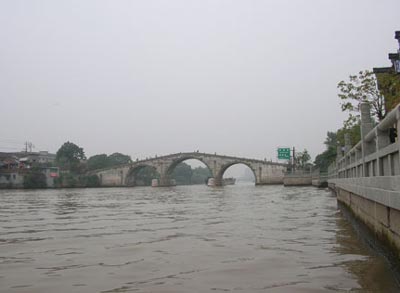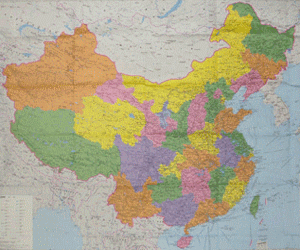|
|
|
China Travel Guide
The Grand Canal of China
(
Beijing Hangzhou Grand Canal) |
|
|
|
Grand Canal of China (Beijinng
- Hangzhou Grand Canal) |
|
THE GRAND CANAL
IS MORE THAN A TOURIST ATTRACTION. IT WOULD BE A
DISASTER TO SEE ITS TREASURE OF STORIES DRAINED.
SHAN JIXIANG DIRECTOR OF STATE ADMINISTRATION OF
CULTURAL HERITAGE
Beijing-Hangzhou
Grand Canal - The Forgotten Jewel of Ancient China
It has existed for more than 2,500 years and has
been a vital vein through which China's lifeblood
has flowed, but conservation experts say the ancient
Grand Canal is an all but forgotten relic that some
people have no interest in protecting.
China announced this month it would be putting
the world's oldest and longest man-made waterway forward in 2014 as
its candidate to join the Great Wall on the UNESCO World Cultural
Heritage list. A total of 35 cities are working on the
"unprecedented" bid, the State Administration of Cultural Heritage
said.
Chinese experts said they
hope the bid, if successful, would boost efforts to preserve a site
many still fail to recognize as one of immense importance. Many
agree, however, the move is decades overdue.
"People know all about the Great Wall but they have no idea about
the Grand Canal because people often only take notice of large and
imposing constructions, not low-level attractions such as a
waterway," said Zhang Tinghao, former director of the Beijing-based
National Cultural Relics Research Institute. "The fact the canal
doesn't look any different from other waterways also makes it easier
for people to take it for granted."
The failure to see the value of the Grand Canal,
especially the cultural landscape it has helped define for past
2,000 years, has resulted in it being neglected, said Luo Zhewen,
president of China Cultural Relics Academy and one of the country's
leading experts in ancient architecture.
"When the Great Wall was listed as a national cultural relic in the
1950s, I also thought of the Grand Canal," said the 85-year-old, who
at the time worked for the State Administration of Cultural
Heritage.
"But few would have. It was still working then, and a cultural relic
was something people associated with static or 'dead' things, such
as the Great Wall."
The Grand Canal was not even recognized as a national cultural relic
site until 2005, he added.
As tourism has boomed over recent years, rushed conservation
projects by towns and cities to turn areas of the canal into glitzy
attractions have also put the waterway at risk.
Sections in the picturesque and popular cities of Hangzhou, Zhejiang
province, and Yangzhou, Jiangsu province, have undergone major
renovations, while the Beijing section has also been transformed
into a waterside park suitable for cycling. Stretches, mostly in the
north, have also dried and become impassable by boat, while some
areas have been reduced to industrial cesspools by persistent
pollution.
 |
"The canal is more than a
tourist attraction," said Shan Jixiang, director of State
Administration of Cultural Heritage, who criticized cities where
officials have destroyed historic sections to garner the canal with
cement plazas and manicured lawns.
"It would be a disaster to see the canal have its treasure of
stories drained by such a process."
The waterway, which was started in the late Spring and Autumn Period
(770-476 BC), runs from Hangzhou to Beijing, winding through some of
China's most fertile and heavily populated lands.
Stretching almost 1,800 km, it is about 16 times longer than the
Suez Canal in Egypt and 33 times the size of the Panama Canal, the
world's second and third largest canals.
In a nation dominated by east-west flowing
rivers, the north-south Grand Canal has provided precious links
between many of China's river systems, operating as a vital artery
for the transporting of food and goods.
It has also played a role in some of China's most
important political and cultural events.
"If the Great Wall is the backbone of the Chinese people, then the
Beijing-Hangzhou Grand Canal is the flesh and blood," said Shan.
The Great Wall has been a World Cultural Heritage
site for more than two decades, but the Grand Canal failed to gain
significant public attention until 2005, when elderly scholars Luo,
Zheng Xiaoxie and Zhu Bingren called for it to be given the same
status. "The ultimate aim is to
ensure the Grand Canal gets the conservation and protection it
deserves," said Luo, 85, who also championed the Great Wall's
inclusion on the UNESCO list in 1987.
His work in raising awareness of the canal began in the 1980s, but
at the time a "world heritage site", as defined in the 1972 World
Heritage Convention, was a static natural or unique site, leaving no
room for working waterways.
The principles were only changed in 1993, when
the El Camino de Santiago, or Way of St. James, a pilgrimage route
in northwestern Spain, made it onto the list, leading to the
International Council on Monuments and Sites (ICOMOS) to call for
the operational guidelines for the status to be updated to include
more cultural routes.
The category was finally confirmed in Feb 2005, clearing the way for
the proposed inclusion of the world famous Silk Road, which is
expected to win approval next year, and the Grand Canal.
"The bid (for the Grand Canal) is progressing
well but it will take another five years until it is fully
prepared," said Shan. "Preparing the application represents an
immense challenge because we have never been confronted by such a
vast cultural site encompassing so many different regions and
disciplines. "The site is simultaneously
cultural and natural. It comprises sites, lines and fields that form
an immense geographical corridor, and includes monuments of the
ancient, early modern and modern periods.
"It also traverses many historical villages, with
fine examples of traditional housing and invaluable items of
intangible cultural heritage."
He added: "Such a voluminous application is, for
us in China, unprecedented."
Conservation expert Zhang said he believes the Grand Canal is one of
the best examples of ancient Chinese engineering, and cites the fact
the canal bed climbs from 1 m below sea level in Hangzhou to 38.5 m
above sea level near the city of Jining, Shandong province, before
dropping to 27 m in Beijing. To achieve this, hundreds of sluice
gates had to be constructed to control water levels and aid
navigation, he said, explaining: "The design and construction of
such sluice gates shows an engineering wisdom that is inspiring even
today." The canal also
bridged the historic culture gaps between north and south China, he
said, and ignorance of its value has undermined efforts to conserve
it.
"Many significant
historical events, beliefs, intellectual trends, important works of
art and folk traditions, even the development of a city have direct
and concrete links with the waterway," Zhang explained. "Beijing
itself is a city borne of the canal. All the bricks used in the
construction of the imperial palaces and mausoleums were transported
from all over the nation via the Grand Canal."
Following calls from conservationists and the public to safeguard
the Grand Canal, an organization to coordinate the efforts of
government departments and provincial authorities was set up in Sept
2007.
"One of our major responsibilities is to ensure the efforts by
participating cities meet with the ICOMOS guidelines," said Meng
Yao, of the general office of the Grand Canal Application for World
Heritage, based in Yangzhou. The office has issued
conservation rules to help towns and cities to draw up plans for the
sections that fall under their jurisdiction, she said.
At the same time, a systematic survey of the
canal's tangible and intangible heritage has been ongoing for two
years and has yielded a long list of relics for further study and
protection over the next five years.
Zhang said he is confident about the 2014 application because he has
witnessed much progress in recent years.
"People are learning more about the Grand Canal
and, as they do, I believe they will do more to help protect the
waterway," he said. "It is too much a part of cultural and
historical heritage for us to just let it slide into disrepair."
Source: China Daily Article By Lin Shujuan (China
Daily) - 2009-06-23 09:45 |
|
|
|
|
|
|
|
ADVERTISEMENT
 |
|
|
|
|
ADVERTISEMENT
 |
|
|
|
|
|
|
|